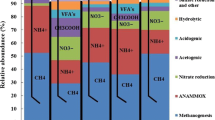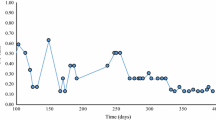Abstract
The tendency in the paper industry is to close all water loops to save water. This leads to higher process temperatures and may increase the colloidal and dissolved material in the process circulation. Increase of nutrients in the water circuits may favor microbiological growth and fouling. In this paper the chemical and microbial compositions of water circuits and deposits were studied of two closed cycled paper/board mills, one mill totally closed (0 m3 waste water t−1), and the other low discharging (about 4 m3 t−1). The zero discharge mill accumulated high amounts (>10 g C L−1) of organic carbon in the circulation waters, about 40% of which composed of volatile acids (lactic, acetic, propionic and butyric acid). Water contents of sulfate, chloride, sodium and calcium increased to >1 g L−1 of each. q-PCR targeted on 16S rRNA genes indicated that the bacteria in water circuits were mainly viable cells. In both mills anaerobic growth (106–108 CFU mL−1) equalled or exceeded aerobic growth, with odor problem but no actual slime problem. The major part (40%) of all identifiable bacterial sequences were closest but yet distant (<96%) to Enterococcus cecorum and in the 4 m3 t−1 discharging mill also Bacillus thermoamylovorans and Bacillus coagulans. Slimes and deposits from the mills contained high amounts, ≥108 g−1, of archaean, but only the genus Methanothrix was identifiable from the cloned sequences. The findings indicate that closing the water circuits strongly limited diversity of the microbiota but allowed efficient mineralization of the dissolved and suspended matter.




Similar content being viewed by others
References
Blanco A (2003) Microbiology in papermaking. Recent Res Dev Appl Microbiol Biotechnol 1:87–134
Blanco MA, Negro C, Gaspar I, Tijero J (1996) Slime problems in the paper and board industry. Appl Microbiol Biotechnol 46:203–208. doi:10.1007/s002530050806
Brochier-Armanet C, Boussau B, Gribaldo S, Forterre P (2008) Mesophilic crenarchaeota: proposal for a third archaeal phylum, the Thaumarchaeota. Nat Rev 6:245–252
Butaye P, Devriese LA, Haesebrouck F (1998) Effects of different test conditions on MICs of food animal growth-promoting antibacterial agents for Enterococci. J Clin Microbiol 36:1907–1911
Combet-Blanc Y, Ollivier B, Streicher C, Patel BKC, Dwivedi PP, Pot B et al (1995) Bacillus thermoamylovorans sp. nov., a Moderately Thermophilic and Amylolytic Bacterium. Int J Syst Bacteriol 45:9–16
Davidson PM, Taylor MT (2007) Chemical Preservatives and natural compounds. In: Doyle MP, Beuchat LT (eds) Food microbiology, fundamentals and frontiers. ASM Press (American Society for Microbiology), Washington DC, pp 713–745
Desjardins E, Beaulieu C (2003) Identification of bacteria contaminating pulp and paper machine in a Canadian paper mill. J Ind Microbiol Biotechnol 30:141–145
DeLong EF (1992) Archaea in coastal marine environments. Proc Natl Acad Sci USA 89:5685–5689. doi:10.1073/pnas.89.12.5685
Edwards U, Rogall T, Blocker H, Emde M, Bottger EC (1989) Isolation and direct complete nucleotide determination of entire genes. Characterization of a gene coding for 16S ribosomal RNA. Nucleic Acids Res 17:7843–7853. doi:10.1093/nar/17.19.7843
Ekman J, Kosonen M, Jokela S, Kolari M, Korhonen P, Salkinoja-Salonen MS (2007) Detection and quantitation of colored deposit-forming Meiothermus spp. in paper industry processes and end products. J Ind Microbiol Biotechnol 34:3–211. doi:10.1007/s10295-006-0187-z
Fortina MG, Ricci G, Mora D, Manchini PL (2004) Molcecular analysis of artisanal Italian cheesed reveals Enterococcus italicus sp. nov. Int J Syst Evol Microbiol 54:1717–1721. doi:10.1099/ijs.0.63190-0
Gautier F, Archibald F (2001) The ecology of “Fecal indicator” bacteria commonly found in pulp and paper mill water systems. Water Res 35:2207–2218. doi:10.1016/S0043-1354(00)00506-6
Grobe KJ, Zahler J, Stewart PS (2002) Role of dose concentration in biocide efficacy against Pseudomonas aeruginosa biofilms. J Ind Microbiol Biotechnol 29:10–15. doi:10.1038/sj.jim.7000256
Hamm U, Schnabel S (2007) Effluent-free papermaking: industrial experiences and latest developments in the German paper industry. Water Sci Technol 65(6):205–211. doi:10.2166/wst.2007.230
Johnsrud SC (2000) Paper mill micro-organisms. Invest Tecnica Papel 146:499–508
Kanto Öqvist L, Jörstad U, Pöntinen H, Johnsen L (2001) Deposit control in the paper industry.In: 3rd ECOPAPERTECH Conference Helsinki, June, pp 269–280, ISBN 951-97513-8-6
Kanto Öqvist L, Salkinoja-Salonen MS, Pelzer R (2005) Novel evaluation methods for paper machine deposits. Prof Papermaking Wochenblatt Papierfabrikation 1:36–42
Kolari M, Mattila K, Mikkola R, Salkinoja-Salonen MS (2001) Mechanism of biofilm formation in paper machine by Bacillus Species: the role of Deinococcus geothermalis. J Ind Microbiol Biotechnol 27:343–351. doi:10.1038/sj.jim.7000201
Kolari M, Nuutinen J, Rainey FA (2003) Colored moderately thermophilic bacteria in paper-machine biofilms. J Ind Microbiol Biotechnol 30:225–238
Lahtinen T, Kosonen M, Tiirola M, Vuento M, Oker-Blom C (2006) Diversity of bacteria contaminating paper machines. J Ind Microbiol Biotechnol 33:734–740. doi:10.1007/s10295-006-0105-4
Lindberg LE, Holmbom BR, Väisänen OM, Weber AM-L, Salkinoja-Salonen MS (2001) Degradation of paper mill water components in laboratory tests with pure cultures of bacteria. Biodegradation 12:141–148. doi:10.1023/A:1013175421662
Maukonen J, Mättö J, Wirtanen G, Raaska L, Mattila-Sandholm T, Saarela M (2003) Methodologies for the characterization of microbes in industrial envionments: a review. J Ind Microbiol Biotechnol 30:327–356. doi:10.1007/s10295-003-0056-y
Mundy LM, Sahm DF, Gilmore M (2000) Relationships between enterococcal virulence and antimicrobial resistance. Clin Microbiol Rev 13:513–522
Philippot P, Zuilen MV, Lepot K, Thomazo C, Farqhuar J, Kranendonk JV (2007) Early Archean microorganisms preferred elemental sulfur, not sulphate. New players in an ancient cycle. Science 317:1534–1537. doi:10.1126/science.1145861
Roest K, Heilig HGHJ, Smidt H, de Vos WM, Stams AJM, Akkermans ADL (2005) Community analysis of a full-scale anaerobic bioreactor treating paper mill wastewater. Syst Appl Microbiol 28:175–185. doi:10.1016/j.syapm.2004.10.006
Rättö M, Suihko M-L, Siika-aho M (2005) Polysaccharide-producing bacteria isolated from paper machine slime deposits. J Ind Microbiol Biotechnol 32:109–114. doi:10.1007/s10295-005-0210-9
Schenker AP, Singelton FL, Davis CK (1998) Proceedings of EUCEPA, Chemistry in Papermaking, 12–14 Oct, pp 331–354
Suihko M-L, Sinkko H, Partanen L, Mattila-Sandholm T, Salkinoja-Salonen M, Raaska L (2004) Description of heterotrophic bacteria occurring in paper mills and paper products. J Appl Microbiol 97:122–1235. doi:10.1111/j.1365-2672.2004.02416.x
Suzuki MT, Taylor LT, DeLong EF (2000) Quantitative analysis of small-subunit rRNA genes in mixed microbial populations via 59-nuclease assays. Appl Environ Microbiol 66:4605–4614. doi:10.1128/AEM.66.11.4605-4614.2000
Väisänen O, Elo S, Marmo S, Salkinoja-Salonen MS (1989) Enzymatic characterization of Bacilli from food packaging paper and board machines. J Ind Microbiol N Y 4:419–428. doi:10.1007/BF01569637
Väisänen OM, Weber A, Bennasar A, Rainey FA, Busse H-J, Salkinoja-Salonen MS (1998) Microbial communities of printing paper machines. J Appl Microbiol 84:1069–1084. doi:10.1046/j.1365-2672.1998.00447.x
Väisänen OM, Nurmiaho-Lassila E-L, Marmo SA, Salkinoja-Salonen MS (1994) Structure and composition of biological slimes on paper and board machines. Appl Environ Microbiol 60:641–653
Wang Q, Garrity MG, Tiedje JM, Cole JR (2007) Naïve Bayesian classifier for rapid assignment of rRNA sequences into the new bacterial taxonomy. Appl Environ Microbiol 73:5261–5267. doi:10.1128/AEM.00062-07
Acknowledgments
This work was supported by Ashland Deutschland GmbH (L.K.Ö., S I., J.S.), Academy of Finland Center of Excellence grant Nr. 118637 (J.K., M.S.S.) and by Ph.D. scholarships from the graduate school for Applied Biosciences (ABS) (to J.P.) and EnSTe graduates school (to J.E.). We also thank Helsinki University Viikki Science Library for excellent information services, the Faculty of Agriculture and Forestry Instrument Center for technical support, and Paulina Lankinen and Tuula Suortti for many kinds of help.
Author information
Authors and Affiliations
Corresponding author
Rights and permissions
About this article
Cite this article
Kanto Öqvist, C., Kurola, J., Pakarinen, J. et al. Prokaryotic microbiota of recycled paper mills with low or zero effluent. J Ind Microbiol Biotechnol 35, 1165–1173 (2008). https://doi.org/10.1007/s10295-008-0396-8
Received:
Accepted:
Published:
Issue Date:
DOI: https://doi.org/10.1007/s10295-008-0396-8




